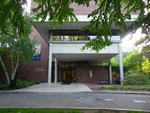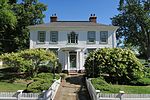John Payson Williston Observatory
1881 establishments in MassachusettsAmerican astronomical observatory stubsAstronomical observatories in MassachusettsBuildings and structures in South Hadley, MassachusettsMount Holyoke College ... and 1 more
Peabody and Stearns buildings

The John Payson Williston Observatory is an astronomical observatory located at the highest point on the Mount Holyoke College campus. Constructed in 1881, the observatory is a modest building with a 24-inch Ritchey-Chretien reflector optical telescope. It is maintained and operated by the Mount Holyoke College Astronomy Department.
Excerpt from the Wikipedia article John Payson Williston Observatory (License: CC BY-SA 3.0, Authors, Images).John Payson Williston Observatory
Jewett Lane,
Geographical coordinates (GPS) Address External links Nearby Places Show on map
Geographical coordinates (GPS)
| Latitude | Longitude |
|---|---|
| N 42.256027777778 ° | E -72.577583333333 ° |
Address
Williston Observatory (John Payson Williston Observatory)
Jewett Lane
01075
Massachusetts, United States
Open on Google Maps






